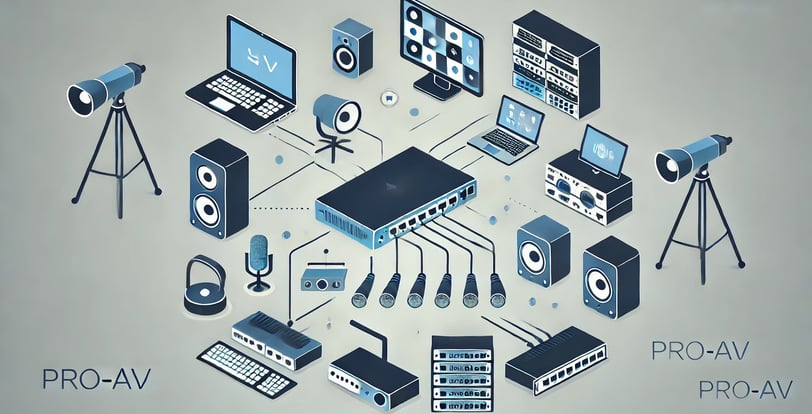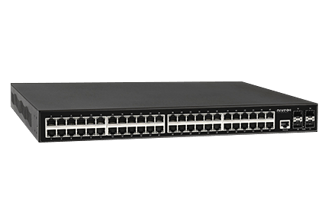"Scalability in Pro-AV Networks: Planning for Growth"
#AVCentricNetworking #Avixa, #Cedia, #AVNU, #SDVoE #AVoIP #AVoverIP #proav #AVTweeps
Arthur de Jager - Niveo Professional
10/3/20244 min read


Scalability in Pro-AV Networks: Planning for Growth
Introduction
In the rapidly evolving world of professional audio-visual (Pro-AV) networks, scalability is a crucial factor that integrators must consider to ensure long-term success. As businesses and institutions increasingly rely on AV technology for communication, collaboration, and entertainment, the ability to expand and adapt AV networks without significant overhauls becomes essential. Planning for growth in Pro-AV networks involves understanding current needs, anticipating future demands, and implementing flexible solutions that can accommodate expansion. This blog explores the key aspects of scalability in Pro-AV networks and offers strategies for planning for growth. Additionally, we will discuss how Niveo Professional contributes to scalable Pro-AV solutions.
Understanding Scalability in Pro-AV Networks
Scalability refers to the capacity of a network to handle an increasing amount of work or its potential to be enlarged to accommodate that growth. In the context of Pro-AV networks, scalability encompasses several dimensions:
Bandwidth Capacity: Ensuring the network can support increased data traffic, including high-definition video, audio streams, and control signals.
Device Integration: The ability to add more AV devices such as cameras, microphones, displays, and speakers without compromising performance.
Network Management: Efficiently managing and configuring a growing number of devices and connections.
Future-Proofing: Implementing technologies and standards that will remain relevant as the AV industry evolves.
Key Considerations for Planning Scalable Pro-AV Networks
1. Assess Current and Future Needs
The first step in planning for scalability is to conduct a thorough assessment of current AV requirements and anticipate future needs. Consider factors such as:
Current Usage: Analyze the current bandwidth consumption, number of connected devices, and typical use cases.
Growth Projections: Estimate future growth in terms of user numbers, device additions, and data traffic increases.
Technology Trends: Stay informed about emerging AV technologies and standards that could impact future network requirements.
2. Invest in High-Bandwidth Infrastructure
A scalable Pro-AV network requires robust infrastructure capable of handling increased data traffic. Key components include:
High-Speed Ethernet: Use Gigabit or higher-speed Ethernet connections to ensure sufficient bandwidth.
Fiber Optic Cables: For long-distance data transmission, fiber optic cables offer higher bandwidth and lower latency compared to traditional copper cables.
Advanced Switches and Routers: Deploy switches and routers that support high data throughput and advanced features like Quality of Service (QoS) and VLANs.
3. Implement Modular and Flexible Solutions
Modular and flexible network solutions allow for easier expansion and reconfiguration. Consider the following:
Modular Switches: Use switches with modular design to add or remove ports as needed.
Scalable AV Systems: Choose AV systems that can be easily expanded with additional units or components.
Wireless Integration: Incorporate wireless AV solutions where appropriate to reduce cabling complexity and facilitate reconfiguration.
4. Leverage Network Segmentation
Segmenting the network using Virtual Local Area Networks (VLANs) can improve scalability and performance. Benefits include:
Traffic Isolation: Separate AV traffic from other network traffic to reduce congestion and improve reliability.
Simplified Management: Manage different segments independently, making it easier to troubleshoot and optimize each part of the network.
Enhanced Security: Protect sensitive AV data by isolating it from general network traffic.
5. Utilize Cloud-Based and Remote Management Tools
Cloud-based and remote management tools provide greater flexibility and control over growing AV networks. Advantages include:
Remote Monitoring: Monitor network performance and troubleshoot issues from any location.
Scalable Management: Easily manage an increasing number of devices and connections without on-site intervention.
Automated Updates: Ensure all devices and software are up-to-date with the latest security patches and features.
6. Prioritize Redundancy and Reliability
As AV networks grow, ensuring reliability becomes more critical. Implement redundancy to maintain uptime and performance:
Redundant Links: Use multiple network links to provide backup in case of failure.
Failover Mechanisms: Implement failover protocols to automatically switch to backup systems if primary systems fail.
Power Redundancy: Use uninterruptible power supplies (UPS) and redundant power sources to keep devices operational during power outages.
Real-World Applications of Scalable Pro-AV Networks
1. Corporate Environments
In corporate settings, scalable AV networks are essential for supporting large-scale video conferencing, digital signage, and collaborative workspaces. As companies grow and expand, their AV needs evolve, requiring additional conference rooms, displays, and collaborative tools. A scalable network ensures that these additions can be made seamlessly without disrupting existing operations.
2. Educational Institutions
Educational institutions increasingly rely on AV technology for lectures, remote learning, and campus-wide communications. As enrollment numbers rise and new technologies emerge, scalable AV networks enable schools and universities to expand their capabilities. This includes adding new lecture halls, incorporating interactive learning tools, and enhancing campus security systems.
3. Event Venues
Event venues such as stadiums, concert halls, and convention centers require flexible and scalable AV networks to accommodate varying event sizes and technical requirements. A robust, scalable network allows these venues to quickly adapt to different setups, from small meetings to large-scale concerts, ensuring optimal performance and audience experience.
The Role of Niveo Professional in Scalability
Niveo Professional plays a pivotal role in ensuring the scalability of Pro-AV networks. Their high-performance switches and networking solutions are designed to handle increasing data traffic and support a growing number of AV devices. Niveo Professional switches offer advanced features such as modular port design, high-speed Ethernet, and robust QoS, making it easy to expand and manage AV networks efficiently.
Moreover, Niveo Professional’s commitment to reliability and future-proofing means that their products are built to support emerging AV technologies and standards. This ensures that as your AV network grows, it remains compatible with the latest advancements in the industry. By integrating Niveo Professional solutions, AV integrators can confidently plan for growth, knowing that their networks will remain scalable, reliable, and high-performing.
In conclusion, planning for scalability in Pro-AV networks is essential for accommodating future growth and ensuring long-term success. By assessing current and future needs, investing in robust infrastructure, implementing flexible solutions, and leveraging advanced management tools, integrators can build scalable networks that meet the evolving demands of their clients. Niveo Professional provides the high-performance solutions necessary to support these scalable networks, ensuring that AV installations can grow and adapt seamlessly.
About Niveo Professional
Niveo Professional is a leading manufacturer of Network Equipment for pro-AV. A pioneer in the industry, that has brought many innovations to make life of the Integrator Easy!
About Arthur de Jager
Arthur de Jager is co-founder of Niveo Professional, Entrepreneur and author and active in the AV-industry for over 30 Years.






